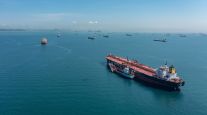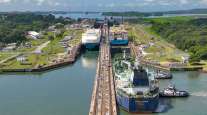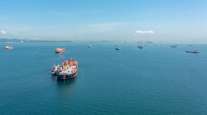New Panama Canal to Alter Global Logistics
This story appears in the July 11 print edition of Transport Topics.
Now that the expanded Panama Canal is open for business, changes to global shipping patterns will be far-reaching and gradual, experts said.
“There is a going to be a restructuring in the way cargo gets there,” Dan Smith, a principal at freight consulting firm Tioga Group, told Transport Topics. “There is not going to be a huge change in volume, but there will be fewer sailings as cargo is condensed onto larger ships.”
The cargo restructuring is linked to decisions by alliances of lines that have consolidated freight on each others’ ships to cut costs amid falling rates and overcapacity on the world’s maritime trade routes, said Smith. Some alliances already have announced changes, deploying ships with 8,500 TEUs, or industry standard 20-foot equivalent units. Those vessels are about 70% larger than the previous maximum size before the expansion. Some alliance-related changes won’t come until at least March, when six lines, which formed THE Alliance, plan to begin operations.
Mitsui O.S.K Lines, NYK Line, “K” Line, Hanjin Shipping, Hapag- Lloyd and Yang Ming Line make up THE alliance.
Another change Smith identified is that some shipments from Asia currently using the Suez Canal to reach the U.S. East Coast will switch to Panama because of shorter transit time.
For trucking, Smith said there will be one noticeable change in the form of “peaking,” which dumps more cargo in a shorter period of time when larger vessels arrive.
“That has the potential to increase congestion,” Smith said.
Growing congestion already has surfaced as a problem in major ports because of the larger amount of cargo handled in a compressed time period and the fact that the presence of multiple carriers’ freight on a single vessel complicates terminal operations.
Curtis Whalen, executive director of American Trucking Associations’ Intermodal Motor Carriers Conference, also told TT that he feared increased congestion because it reduces drivers’ productivity and efficiency.
Celebration of the newly expanded Panama Canal occurred June 26 with the fanfare of an Asia-bound China Ocean Shipping Co. vessel, the Panama, making the first commercial trip.
“More than 100 years ago, the Panama Canal connected two oceans. Today, we connect the present and the future,” said Panama Canal Administrator Jorge Quijano.
The canal now accommodates 14,000 TEU vessels, after a $5.25 billion project that opened nearly two years late due to construction issues and cost overrun disputes.
U.S. ports executives, particularly for those on the East Coast, have anticipated what the expansion means for them.
Georgia Gov. Nathan Deal, whose state is home to fourth-largest U.S. port at Savannah, hailed the expansion as “one of the largest and most important civil works projects in recent memory.” Savannah handled 30% of import containers through East Coast ports.
“We expect fiscal year 2017 to be marked by an increased frequency of big ship calls once the Panama Canal expansion opens and multiple services upgrade the size of vessels deployed to Charleston,” said Jim Newsome, who heads South Carolina’s port authority.
The optimism is driven by East and Gulf Coast ports’ 3.5 percentage point market share gain in less than two years, in part because of West Coast labor disruptions, according to data compiled by consulting firm IHS Global Insight.
The ports have scaled back their optimism from initial comments at a congressional hearing, where their combined market share gain expectations totaled more than 100%, Whalen said.
Whalen also said shippers “still want good service” no matter what port they use, adding that West Coast ports’ efficiency is much improved.
IHS said in a statement that while the canal’s expansion creates “greater economies of scale, it’s far from certain those gains will be passed onto shippers.”
From the shipper standpoint, consultant Mike Regan said, “This is a big change we need to pay attention to. The impact of these game changers are rarely immediate.”
He noted the potential impact on inventory needs as those ships that switch to the Panama Canal from Suez can save about two weeks in transit time.
Regan also noted that more port terminals still need to be built in Panama.
Railroads that currently handle container cargo also will be affected as freight travels farther by water and less on trains, said rail consultant Anthony Hatch.
“I continue to believe that most of the share loss from Western ports to Eastern ports has occurred already,” he said in a report.
Hatch and Whalen both noted that the largest East Coast port, New York-New Jersey, still isn’t ready for larger ships.
The impediment in New York-New Jersey is a project to raise the Bayonne Bridge so that larger ships can be handled, which isn’t expected until late next year.




